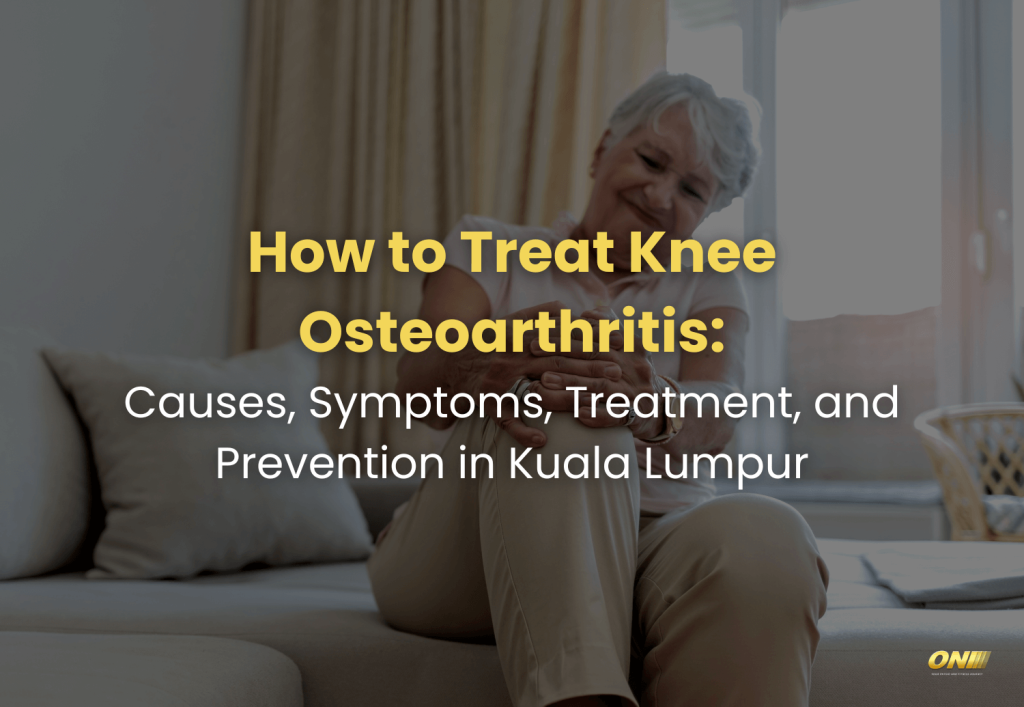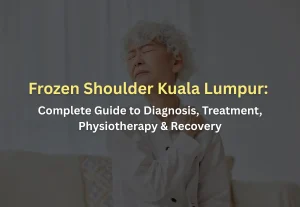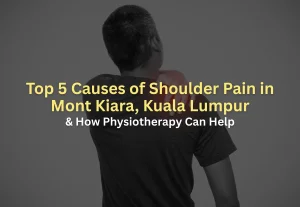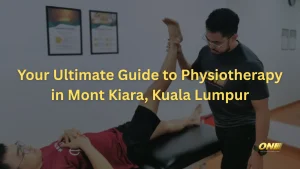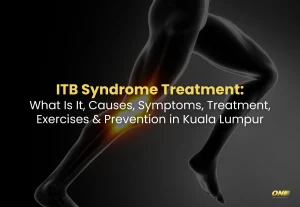Introduction
Knee osteoarthritis (OA) is a common condition affecting many people, especially as they age, leading to chronic knee pain and decreased mobility. It’s a degenerative joint disease that can make simple activities like walking, standing, or bending painful and difficult. Fortunately, with the right treatment approach, including physiotherapy, knee osteoarthritis can be managed effectively.
If you’re based in Mont Kiara or Kuala Lumpur, ONI Physio Fitness provides expert care and personalized treatment to help you manage knee OA and regain a better quality of life.
What is Knee Osteoarthritis?
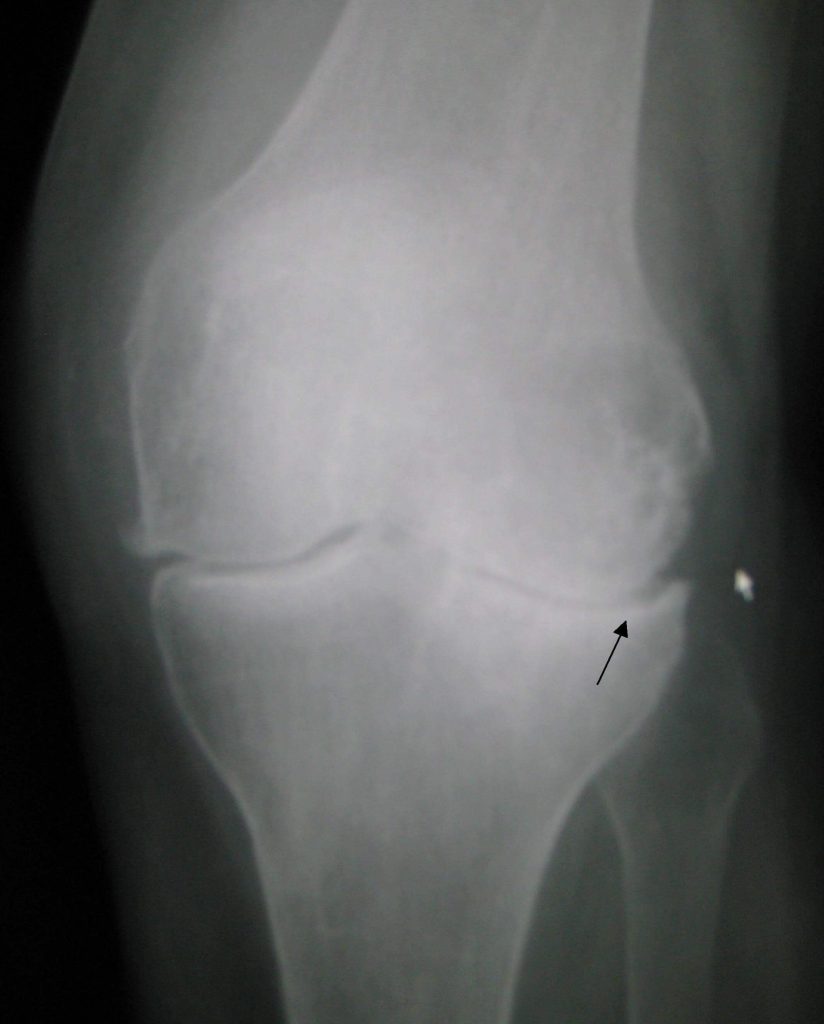
James Heilman, MD, CC BY-SA 3.0 <https://creativecommons.org/licenses/by-sa/3.0>, via Wikimedia Commons
Knee osteoarthritis is a degenerative joint disease where the cartilage between the knee joint gradually wears away, leading to pain, stiffness, and inflammation.
This condition typically affects people over 50, but it can also occur in younger individuals due to injuries or genetic factors.
With age, the body’s natural ability to repair cartilage decreases, leading to joint damage that results in knee pain and limited mobility.
Causes of Knee Osteoarthritis
Knee osteoarthritis can develop due to various factors, including:
- Aging
The risk of knee OA increases with age, as the body’s cartilage naturally deteriorates over time. - Genetics
Family history of osteoarthritis can predispose individuals to knee OA. - Injury or Trauma
Past injuries like fractures, ligament tears, or meniscus injuries can contribute to joint degeneration, increasing the likelihood of knee OA. - Obesity
Excess weight puts added stress on the knee joints, accelerating the wear and tear of cartilage. - Repetitive Strain from Physical Activities
Jobs or sports that involve frequent kneeling, squatting, or heavy lifting can strain the knee and contribute to joint degeneration over time.
Symptoms of Knee Osteoarthritis
Symptoms of knee osteoarthritis can vary, but common signs include:
- Knee Pain: Pain that worsens with movement or after prolonged periods of rest.
- Stiffness: Difficulty bending or straightening the knee, especially in the morning or after sitting.
- Swelling: Inflammation around the knee joint due to cartilage wear.
- Grinding Sensation: A feeling of bone rubbing against bone or popping sounds when moving the knee.
- Reduced Range of Motion: Difficulty performing everyday activities like climbing stairs or getting out of a chair.
These symptoms tend to worsen over time, especially without treatment.
Diagnosis of Knee Osteoarthritis
A proper diagnosis is essential to understanding the severity of knee osteoarthritis and developing an effective treatment plan. At ONI Physio Fitness in Mont Kiara, Kuala Lumpur, our trained physiotherapists will conduct a thorough assessment, which may include a review of medical history and physical examination.
By identifying the extent of cartilage loss and areas of discomfort, we can create a personalized treatment approach to address your specific needs.
Knee Osteoarthritis Treatment
Effective management of knee OA aims to reduce pain, improve mobility, and prevent further joint damage. At ONI Physio Fitness, we offer various treatments to help manage knee osteoarthritis:
- Physiotherapy
Physiotherapy is a cornerstone of knee OA treatment. Our physiotherapists use targeted exercises, manual therapy, and joint mobilization techniques to reduce pain and improve joint function. Strengthening the surrounding muscles can support the knee and lessen stress on the joint. - Manual Therapy
Techniques like joint mobilization and soft tissue massage help relieve stiffness, improve circulation, and reduce pain. These hands-on techniques can be especially beneficial for maintaining knee flexibility and function. - Ultrasound and Electrical Stimulation
Ultrasound and electrical stimulation therapies can be effective for chronic knee pain by promoting blood flow and reducing inflammation, which helps speed up the healing process. - Personalized Treatment Plans
Every patient’s experience with knee OA is unique, so our physiotherapists create tailored treatment plans to target individual needs, helping them regain function and alleviate discomfort.
Below is a case study on how ONI Physio Fitness treats knee osteoarthritis with personalized physiotherapy plans to help our client, Wai Ying, return to daily life.
If you are experiencing knee osteoarthritis, visit ONI Physio Fitness in Mont Kiara, Kuala Lumpur, for a customized treatment plan designed to improve your knee health and quality of life.
Exercises for Knee Osteoarthritis
Exercise is crucial for managing knee OA, as it helps improve mobility, flexibility, and muscle strength. Here are three recommended exercises for knee osteoarthritis:
Quadriceps Set
- Sit with your legs straight in front of you.
- Tighten your thigh muscle, pressing the back of your knee down toward the floor.
- Hold for 5 seconds, then relax.
- Repeat for 2–3 sets of 10–15 repetitions on each leg.
Heel Slide
- Lie on your back with one leg extended and the other bent.
- Slowly slide the heel of the bent leg towards your glutes, bending the knee.
- Hold for a few seconds, then slide the heel back to the starting position.
- Perform 2–3 sets of 10 reps per leg. This exercise improves knee flexibility.
Calf Stretch
- Stand facing a wall and place one foot in front of the other, with the back heel flat on the ground.
- Lean into the wall, feeling a stretch in the back calf.
- Hold for 15–20 seconds, then switch legs.
- Repeat 2–3 times on each leg. This stretch helps improve the flexibility of the muscles surrounding the knee.
Performing these exercises regularly can help alleviate pain and improve knee function. However, always consult with a physiotherapist to ensure you’re doing them correctly and safely.
Prevention for Knee Osteoarthritis
Preventing knee osteoarthritis or managing its progression involves lifestyle changes and attention to joint health. Here are a few preventive strategies:
- Maintain a Healthy Weight
Keeping a healthy weight reduces the stress on knee joints, minimizing the risk of joint damage. - Stay Active
Low-impact exercises like walking, swimming, and cycling help keep the knee joints flexible and strengthen the muscles around them. - Practice Good Posture
Avoid putting undue stress on your knees by practicing good posture and maintaining proper alignment during activities. - Avoid High-Impact Activities
Repetitive high-impact exercises can strain the knees. Opt for low-impact activities to protect your knee joints. - Wear Supportive Footwear
Proper shoes help maintain knee alignment and prevent uneven stress on the knee joints.
Conclusion
Knee osteoarthritis is a progressive condition, but with early diagnosis, effective treatment, and preventive measures, you can manage pain and enjoy an active lifestyle.
At ONI Physio Fitness, located in Mont Kiara, Kuala Lumpur, our experienced physiotherapists are dedicated to providing comprehensive assessments and personalized treatment plans to help you manage knee OA and improve joint health.
If knee osteoarthritis is affecting your mobility and quality of life, don’t wait. Visit ONI Physio Fitness in Mont Kiara, Kuala Lumpur, for a professional assessment and effective treatment options tailored to your needs. Contact us today to start your journey toward pain-free movement and better knee health.

